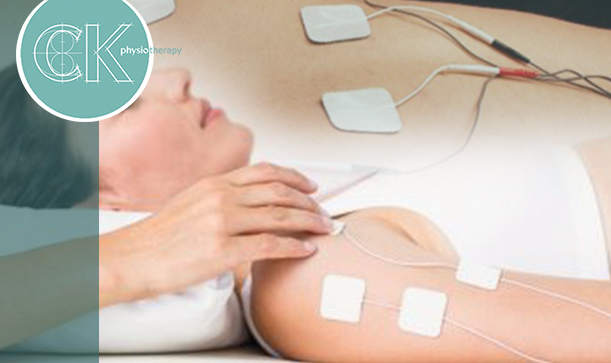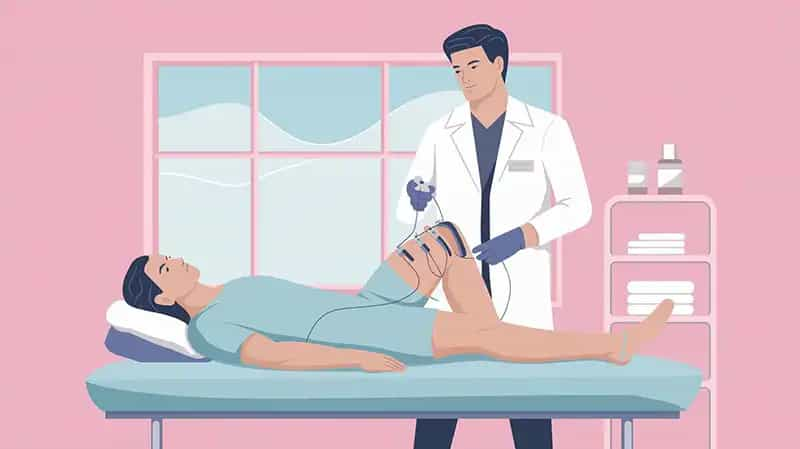

19. September 2019
key benefits of electrotherapy in physiotherapy treatments
Physiotherapists use various tools to manage pain, restore range of motion, and treat musculoskeletal system conditions. In addition to methods like joint mobilisation, stretching, and targeted exercises, your physiotherapist might recommend electrotherapy as a treatment option.
Using specialised devices designed to deliver customised levels of electrical stimulation to your body's nerves, muscles, or tendons, trained physiotherapists can harness the power of electrotherapy to treat injuries, promote healing, and offer pain relief.
Electrotherapy: What it is & How it Works
A powerful tool used by many physiotherapists, electrotherapy treats chronic pain, musculoskeletal injuries, muscle wasting, and nerve pain by using targeted and controlled electrical stimulation.
Electrotherapy is a gentle and non-invasive modality that stimulates nerves and muscles through the skin's surface. Though it varies based on which device your practitioner uses, electrotherapy is thought to work in a variety of ways:
- Send out electrical impulses that block or interfere with the body's pain signals, reducing pain.
- Help release endorphins (chemical messengers) that naturally decrease pain in the body.
- Stimulate muscle tissue to contract to reduce atrophy.
- Create a heating effect within the body, which improves circulation and stimulates healing.
- Stimulate cells which reduce inflammation, promote collagen production, and inhibit pain.
6 Main Types of Electrotherapy Treatment
Though there are many types of electrotherapy treatments available, most sessions involve the same basic setup. In some forms, electrode pads are placed on your skin with adhesives. The pads are connected via wire to the physiotherapist's battery-powered device, which then transmits the electrical signals to your body.
In other forms of electrotherapy, your physiotherapist will use a transducer with gel to transmit specialised ultrasound waves into your body. When you go for a session, your physiotherapist might use one of these methods in treatment:
- Transcutaneous Electrical Nerve Stimulation (TENS)
- Electroacupuncture
- Electrical Muscle Stimulation (EMS)
Transcutaneous Electrical Nerve Stimulation (TENS)
One of the most common electrotherapy treatments, Transcutaneous Electrical Nerve Stimulation (TENS), uses small devices that deliver pulses of electrical stimulation. The goal of the TENS machine is to stimulate sensory nerves to achieve pain relief, and it is often used for both nerve pain and chronic pain conditions.
Therapeutic Ultrasound
Therapeutic ultrasound is used in physiotherapy to boost circulation and stimulate the healing process by deep heating different tissues—like muscles, ligaments, and tendons. This method uses a transducer instead of electrode pads and is often used to treat strains, tendonitis, and knee meniscus tears.
Interferential
Also known as IFT, interferential electrotherapy uses low-frequency electrical stimulation to stimulate muscles, increase blood flow, and reduce pain. IFT is sometimes used for patients who dislike the sensation of TENS electrotherapy.
Electroacupuncture
Ordinarily, acupuncture involves thin needles inserted at specific points that target different organs or bodily systems. Electroacupuncture follows the same principles, except it uses two needles with an electric current passing between them. It's often used to treat chemotherapy side effects and acute pain.
Shockwave Therapy
In shockwave therapy, acoustic waves with high energy are used to treat conditions. Like therapeutic ultrasound, shockwave therapy uses a transducer with gel. This therapy helps stimulate collagen production, release painful trigger points, and reduce inflammation in the body. It's also handy for musculoskeletal conditions like plantar fasciitis, tennis elbow, and Achilles tendinopathy.
Electrical Muscle Stimulation (EMS)
While some methods of electrotherapy target nerves, EMS targets muscle tissue. This specialised form of electrotherapy stimulates motor neurons, which causes muscles to contract. It is often used to treat and prevent muscle atrophy.
6 Benefits of Electrotherapy in Physiotherapy Treatments
Your physiotherapist can help you determine which electrotherapy method works best for you and your needs. Depending on your medical or musculoskeletal condition, electrotherapy can offer several key benefits:
- Reduce nerve pain.
- Promote healing of musculoskeletal injuries.
- Have a non-invasive, drug-free pain control.
- Prevent muscle atrophy.
- Increase circulation for wound repair.
- Have minimal to no side effects.
1. Reduce nerve pain.
Those suffering from nerve pain experience numbness, tingling, burning, muscle weakness, and general pain. Though the causes for nerve pain vary, the pain is attributed to your body's nerves sending out electrical impulses that carry pain signals. In cases of nerve pain, a physiotherapist can use a TENS machine to target and reduce nerve pain by interfering with or "confusing" the pain signals your body transmits.
2. Promote healing of musculoskeletal injuries.
Some electrotherapy modalities, especially shockwave therapy treatment, have been shown to treat a variety of musculoskeletal conditions effectively. Not only can shockwave therapy reduce pain, but it can also help increase blood flow to an injured area, which can stimulate the healing process. You might find that shockwave therapy is helpful for injuries like:
-
Tennis elbow
- Plantar fasciitis
- Carpal tunnel syndrome
- Jumpers knee
- Shoulder pain and injuries
Because electrotherapy can help increase circulation and promote healing in an area, physiotherapists also use it to treat common sports injuries like sprains and strains.
3. Have a non-invasive, drug-free pain control.
Electrotherapy offers a safe, non-toxic, and non-addictive way to handle chronic pain. Whether you suffer from chronic neck or back pain, you know that these conditions can make it difficult to perform activities of daily living and can reduce your quality of life.
Though pain-reducing medication is sometimes a necessary intervention, using electrotherapy for pain relief offers a powerful alternative — without any of the concerns inherent in using habit-forming drugs. In addition, electrotherapy provides a non-invasive way to handle chronic pain and promote tissue repair. Using electrotherapy can, in some cases, prevent the need for invasive interventions like surgery.
4. Prevent muscle atrophy.
When muscles can't be used due to injury, illness, or nerve damage, this can result in muscle atrophy — when a muscle wastes away. Not only does muscle atrophy restrict movement and impact quality of life, but it can also contribute to pain and stiffness. Fortunately, electrotherapy — specifically electrical muscle stimulation (EMS) — can help prevent atrophy by stimulating muscles to contract. Sometimes, EMS is used to stimulate muscles to contract, while a TENS machine is used to help reduce the pain associated with atrophy.
5. Increase circulation for wound repair.
Healthy circulation is an essential aspect of the healing process. Oxygenated blood brings nutrients to our cells and helps jump-start tissue healing. In addition, healthy circulation helps remove toxins from the body to create a healthier body. Studies have shown that electrotherapy devices can significantly enhance blood flow, which boosts the body's ability to heal and repair wounds.
6. Have minimal to no side effects.
Most patients experience pain relief and healing with relatively few side effects regarding electrotherapy treatments. The most common side effect from electrotherapy can often be traced back to the adhesives used in securing the electrode pad to the skin, which can occasionally trigger a rash or allergic reaction on the site. You may experience some slight discomfort during treatment, but electrotherapy is generally a pain-free methodology with no long-lasting side effects.
Frequently Asked Questions About Electrotherapy
Is electrotherapy safe?
Electrotherapy is generally considered safe when administered by a qualified physiotherapist. However, it may not be suitable for everyone. Patients with pacemakers, pregnant women, and those with certain medical conditions should consult their doctor before undergoing electrotherapy treatment.
How long does an electrotherapy session typically last?
The duration of an electrotherapy session can vary depending on the specific treatment and your condition. Most sessions last between 15 to 30 minutes. Your physiotherapist will determine the appropriate length based on your needs and treatment plan.
How many sessions of electrotherapy will I need?
The number of electrotherapy sessions required varies from patient to patient. Factors such as the severity of your condition, your body's response to treatment, and your overall health will influence the treatment plan. Some patients may experience relief after just a few sessions, while others may benefit from a longer course of treatment. Your physiotherapist will assess your progress and adjust the treatment plan accordingly.
Can electrotherapy be combined with other physiotherapy treatments?
Yes, electrotherapy is often used with other physiotherapy techniques for a comprehensive treatment approach. Your physiotherapist may combine electrotherapy with manual therapy, exercise programs, or other modalities to maximize the benefits and achieve optimal results. This integrated approach allows for a tailored treatment plan that addresses your needs and goals.
Are there any conditions where electrotherapy should not be used?
While electrotherapy is generally safe, there are certain conditions where it may be contraindicated. These include:
- Patients with pacemakers or other implanted electrical devices
- Pregnancy (especially in the abdominal or pelvic area)
- Active cancer
- Epilepsy or seizure disorders
- Deep vein thrombosis (DVT)
- Areas with decreased sensation
Always inform your physiotherapist of your complete medical history before beginning any new treatment.How soon can I expect to feel the effects of electrotherapy?
The timeline for experiencing the effects of electrotherapy can vary. Some patients report immediate pain relief or improved mobility after a session, while others may notice gradual improvements over several treatments. Chronic conditions may require more sessions before significant effects are noticed. Your physiotherapist will monitor your progress and adjust the treatment plan to ensure you're getting the most benefit from electrotherapy.
Visit a Trusted Physiotherapist in London
If you are currently experiencing chronic pain or are struggling with musculoskeletal conditions or injuries, then electrotherapy might be a good option for you. To ensure you receive professional care from educated professionals, seek a qualified physiotherapist in London who offers electrotherapy treatment.
Want to learn more? Reach out to CK Physio's caring and compassionate team to get started.
Related info articles
What is Electrotherapy Treatment and How Does It Work
Latest Blogs









.svg)
.svg)